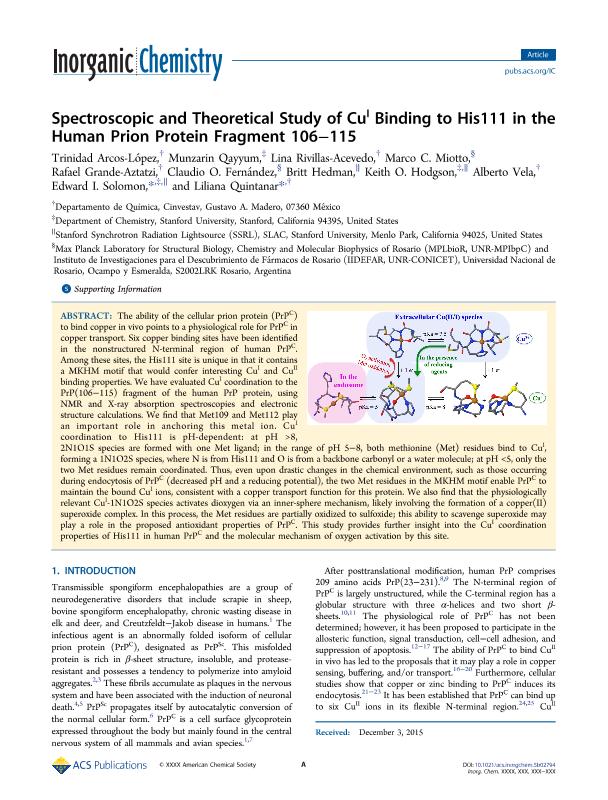Mostrar el registro sencillo del ítem
dc.contributor.author
Arcos López, Trinidad
dc.contributor.author
Qayyum, Munzarin
dc.contributor.author
Rivillas Acevedo, Lina
dc.contributor.author
Miotto, Marco César

dc.contributor.author
Grande Aztatzi, Rafael
dc.contributor.author
Fernandez, Claudio Oscar

dc.contributor.author
Hedman, Britt
dc.contributor.author
Hodgson, Keith O.
dc.contributor.author
Vela, Alberto
dc.contributor.author
Solomon, Edward I.
dc.contributor.author
Quintanar, Liliana

dc.date.available
2018-07-23T17:22:58Z
dc.date.issued
2016-03
dc.identifier.citation
Arcos López, Trinidad; Qayyum, Munzarin; Rivillas Acevedo, Lina; Miotto, Marco César; Grande Aztatzi, Rafael; et al.; Spectroscopic and Theoretical Study of CuI Binding to His111 in the Human Prion Protein Fragment 106-115; American Chemical Society; Inorganic Chemistry; 55; 6; 3-2016; 2909-2922
dc.identifier.issn
0020-1669
dc.identifier.uri
http://hdl.handle.net/11336/52826
dc.description.abstract
The ability of the cellular prion protein (PrPC) to bind copper in vivo points to a physiological role for PrPC in copper transport. Six copper binding sites have been identified in the nonstructured N-terminal region of human PrPC. Among these sites, the His111 site is unique in that it contains a MKHM motif that would confer interesting CuI and CuII binding properties. We have evaluated CuI coordination to the PrP(106-115) fragment of the human PrP protein, using NMR and X-ray absorption spectroscopies and electronic structure calculations. We find that Met109 and Met112 play an important role in anchoring this metal ion. CuI coordination to His111 is pH-dependent: at pH >8, 2N1O1S species are formed with one Met ligand; in the range of pH 5-8, both methionine (Met) residues bind to CuI, forming a 1N1O2S species, where N is from His111 and O is from a backbone carbonyl or a water molecule; at pH <5, only the two Met residues remain coordinated. Thus, even upon drastic changes in the chemical environment, such as those occurring during endocytosis of PrPC (decreased pH and a reducing potential), the two Met residues in the MKHM motif enable PrPC to maintain the bound CuI ions, consistent with a copper transport function for this protein. We also find that the physiologically relevant CuI-1N1O2S species activates dioxygen via an inner-sphere mechanism, likely involving the formation of a copper(II) superoxide complex. In this process, the Met residues are partially oxidized to sulfoxide; this ability to scavenge superoxide may play a role in the proposed antioxidant properties of PrPC. This study provides further insight into the CuI coordination properties of His111 in human PrPC and the molecular mechanism of oxygen activation by this site.
dc.format
application/pdf
dc.language.iso
eng
dc.publisher
American Chemical Society

dc.rights
info:eu-repo/semantics/openAccess
dc.rights.uri
https://creativecommons.org/licenses/by-nc-sa/2.5/ar/
dc.subject
Cu(I)
dc.subject
Prion Protein
dc.subject
Biophysics
dc.subject.classification
Otras Ciencias Químicas

dc.subject.classification
Ciencias Químicas

dc.subject.classification
CIENCIAS NATURALES Y EXACTAS

dc.title
Spectroscopic and Theoretical Study of CuI Binding to His111 in the Human Prion Protein Fragment 106-115
dc.type
info:eu-repo/semantics/article
dc.type
info:ar-repo/semantics/artículo
dc.type
info:eu-repo/semantics/publishedVersion
dc.date.updated
2018-07-18T20:41:58Z
dc.journal.volume
55
dc.journal.number
6
dc.journal.pagination
2909-2922
dc.journal.pais
Estados Unidos

dc.journal.ciudad
Washington
dc.description.fil
Fil: Arcos López, Trinidad. Instituto Politécnico Nacional. Centro de Investigación y de Estudios Avanzado; México
dc.description.fil
Fil: Qayyum, Munzarin. University of Stanford; Estados Unidos
dc.description.fil
Fil: Rivillas Acevedo, Lina. Instituto Politécnico Nacional. Centro de Investigación y de Estudios Avanzado; México
dc.description.fil
Fil: Miotto, Marco César. Consejo Nacional de Investigaciones Científicas y Técnicas. Centro Científico Tecnológico Conicet - Rosario. Instituto de Investigaciones para el Descubrimiento de Fármacos de Rosario. Universidad Nacional de Rosario. Instituto de Investigaciones para el Descubrimiento de Fármacos de Rosario; Argentina. Max Planck Laboratory for Structural Biology; Argentina
dc.description.fil
Fil: Grande Aztatzi, Rafael. Instituto Politécnico Nacional. Centro de Investigación y de Estudios Avanzado; México
dc.description.fil
Fil: Fernandez, Claudio Oscar. Consejo Nacional de Investigaciones Científicas y Técnicas. Centro Científico Tecnológico Conicet - Rosario. Instituto de Investigaciones para el Descubrimiento de Fármacos de Rosario. Universidad Nacional de Rosario. Instituto de Investigaciones para el Descubrimiento de Fármacos de Rosario; Argentina. Max Planck Laboratory for Structural Biology; Argentina
dc.description.fil
Fil: Hedman, Britt. University of Stanford; Estados Unidos
dc.description.fil
Fil: Hodgson, Keith O.. University of Stanford; Estados Unidos
dc.description.fil
Fil: Vela, Alberto. Instituto Politécnico Nacional. Centro de Investigación y de Estudios Avanzado; México
dc.description.fil
Fil: Solomon, Edward I.. University of Stanford; Estados Unidos
dc.description.fil
Fil: Quintanar, Liliana. Instituto Politécnico Nacional. Centro de Investigación y de Estudios Avanzado; México
dc.journal.title
Inorganic Chemistry

dc.relation.alternativeid
info:eu-repo/semantics/altIdentifier/doi/https://dx.doi.org/10.1021/acs.inorgchem.5b02794
dc.relation.alternativeid
info:eu-repo/semantics/altIdentifier/url/https://pubs.acs.org/doi/10.1021/acs.inorgchem.5b02794
Archivos asociados
